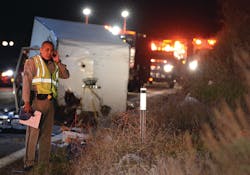According to the United States Census Bureau, nearly 11 billion traffic accidents occur each year. This means that law enforcement professionals respond to a “routine traffic accident” on a nearly daily basis. But what happens when you show up on the site of a tractor trailer accident and find the flat bed of the 18-wheeler filled with a jumbled mess of minimally labeled metal drums? You could ask the driver for shipping documents, but what if the driver is unconscious or the documentation isn't accessible?
Proper stabilization, containment and response to chemical spills is critical to ensure safety not only for the people involved and responding to the incident, but also for the environment and citizens in close proximity to it. Unfortunately, locating all the information necessary to provide the most effective response to an incident is not always easy to do. Remember these three things in the first moments when you realize a routine traffic accident is anything but routine:
- Retrieve as much relevant information from the scene as safely possible
- Be aware of and engage emergency response information resources
- Make those resources available to the responders who will be responsible for mitigating the incident
1. Retrieve relevant information
It is crucial for a first responder to locate and identify as much information as possible, but only after securing the incident scene and ensuring his or her own safety and the safety of others. Relevant information related to the hazards posed by the involved materials may be found on placards, shipping documents, or container labels. Information such as the location and nature of the incident, type and amount of product(s) involved, shipper/manufacturer, consignee, carrier, type of container, and other details are also important. Some of this information may not be immediately available or may not be immediately obvious or accessible. If this is the case, it’s time to start some detective work.
Shipping documents provide hazard information and proper shipping names which, when used in conjunction with the U.S. Department of Transportation’s Emergency Response Guidebook (ERG), provide useful response information. When shipping documents are not accessible, the hazmat placards placed on transport vehicles and bulk containers, and labels placed on individual containers, provide hazard information which can also be used in conjunction with the ERG.
If hazmat placards or labels are not visible, additional labels or tags on containers can provide clues to the contents, such as a trade name of the product or the manufacturer’s logo.
2. Engage other resources
If shipping documents are readily accessible, it should be fairly easy to find an emergency phone number. That number is required by regulation for hazmat shipments. The intent of this number is to provide first responders with information that can assist in identifying additional information that will help in the response. It may be a hazardous materials shipper, chemical manufacturer, or a third-party emergency response information service.
Even if these shipping documents are not available, emergency response information providers can track down information based on package labels, manufacturer’s information, product name, or sometimes even with just the descriptive information relative to the trucking company involved. Emergency response centers typically employ top-of-the-line technology to ensure they can effectively assist first responders. The company CHEMTREC utilizes three levels of technology to provide services to the response community:
- Information—Protech Cloud Business Solutions (PCBS) powered by Microsoft Dynamics CRM, is a fully integrated financial, customer relationship, and document and resource management system hosted through Cetrom Cloud Computing services.
- Communication—Four layers of phone systems, using PRIs, VoIP, cellular and POTS, as well as integrated email and fax capabilities.
- Access from anywhere—“Go kits” with laptops, VoIP headsets and handheld mobile devices.
3. Resources at your fingertips
CHEMTREC calls are answered by an emergency service specialist who is Pro-Board Certified NFPA 472 as a Hazardous Materials Technician and frequently possesses emergency response experience from the military, bomb disposal squads, or as a former paramedic or firefighter. This is the person tasked with helping first responders determine the best way to neutralize the situation.
Using the information gathered in step one, a first responder should provide as much background as possible to the emergency service specialist.
Once the hazardous material and its shipper or manufacturer has been identified, the first responder’s next priority is to stabilize the situation. He or she might seek additional expertise or suggestions from a wide range of experts, such as chemists, medical professionals, toxicologists, and language interpreters. In addition, organizations like CHEMTREC works closely with a number of federal agencies and product-specific mutual assistance groups with a specialized expertise with certain products.
At this point, typically within the first minutes, a first-on-scene responder and the relieving hazmat team have gained timely access to a wide range of information that can help safely and efficiently handle the situation.
Randy Speight
Randy Speight is the Managing Director of CHEMTREC® (www.chemtrec.com), a public service hotline for emergency responders, such as fire fighters and law enforcement personnel, to obtain information and assistance for emergency incidents involving chemicals and hazardous materials. CHEMTREC is a service of the American Chemistry Council (ACC). Speight has worked for CHEMTREC since 1998, and the American Chemistry Council since 1991. In his previous positions with ACC, he worked with leading chemical companies to develop industry-wide safety and performance improvement initiatives. Prior to joining ACC, Speight served for more than 20 years as a U.S. Coast Guard Officer.
Erika Palfrey
Erika Palfrey is the Senior Director of Technical Resources and Information Management for CHEMTREC® (www.chemtrec.com), a public service hotline for emergency responders, such as fire fighters and law enforcement personnel, to obtain information and assistance for emergency incidents involving chemicals and hazardous materials. CHEMTREC is a service of the American Chemistry Council (ACC). Since joining CHEMTREC in 2003, Palfrey replaced CHEMTREC’s core systems, and transitioned the primary systems to a cloud-based environment in 2009. Palfrey’s previous experience includes software development, online systems, call center management, and managing information systems.



